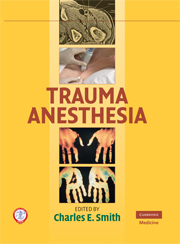Book contents
- Frontmatter
- Contents
- Foreword
- Foreword
- Preface
- Acknowledgments
- Contributors
- 1 Mechanisms and Demographics in Trauma
- 2 Trauma Airway Management
- 3 Shock Management
- 4 Establishing Vascular Access in the Trauma Patient
- 5 Monitoring the Trauma Patient
- 6 Fluid and Blood Therapy in Trauma
- 7 Massive Transfusion Protocols in Trauma Care
- 8 Blood Loss: Does It Change My Intravenous Anesthetic?
- 9 Pharmacology of Neuromuscular Blocking Agents and Their Reversal in Trauma Patients
- 10 Anesthesia Considerations for Abdominal Trauma
- 11 Head Trauma – Anesthesia Considerations and Management
- 12 Intensive Care Unit Management of Pediatric Brain Injury
- 13 Surgical Considerations for Spinal Cord Trauma
- 14 Anesthesia for Spinal Cord Trauma
- 15 Musculoskeletal Trauma
- 16 Anesthetic Considerations for Orthopedic Trauma
- 17 Cardiac and Great Vessel Trauma
- 18 Anesthesia Considerations for Cardiothoracic Trauma
- 19 Intraoperative One-Lung Ventilation for Trauma Anesthesia
- 20 Burn Injuries (Critical Care in Severe Burn Injury)
- 21 Anesthesia for Burns
- 22 Field Anesthesia and Military Injury
- 23 Eye Trauma and Anesthesia
- 24 Pediatric Trauma and Anesthesia
- 25 Trauma in the Elderly
- 26 Trauma in Pregnancy
- 27 Oral and Maxillofacial Trauma
- 28 Damage Control in Severe Trauma
- 29 Hypothermia in Trauma
- 30 ITACCS Management of Mechanical Ventilation in Critically Injured Patients
- 31 Trauma and Regional Anesthesia
- 32 Ultrasound Procedures in Trauma
- 33 Use of Echocardiography and Ultrasound in Trauma
- 34 Pharmacologic Management of Acute Pain in Trauma
- 35 Posttrauma Chronic Pain
- 36 Trauma Systems, Triage, and Transfer
- 37 Teams, Team Training, and the Role of Simulation in Trauma Training and Management
- Index
- Plate section
- References
14 - Anesthesia for Spinal Cord Trauma
Published online by Cambridge University Press: 18 January 2010
- Frontmatter
- Contents
- Foreword
- Foreword
- Preface
- Acknowledgments
- Contributors
- 1 Mechanisms and Demographics in Trauma
- 2 Trauma Airway Management
- 3 Shock Management
- 4 Establishing Vascular Access in the Trauma Patient
- 5 Monitoring the Trauma Patient
- 6 Fluid and Blood Therapy in Trauma
- 7 Massive Transfusion Protocols in Trauma Care
- 8 Blood Loss: Does It Change My Intravenous Anesthetic?
- 9 Pharmacology of Neuromuscular Blocking Agents and Their Reversal in Trauma Patients
- 10 Anesthesia Considerations for Abdominal Trauma
- 11 Head Trauma – Anesthesia Considerations and Management
- 12 Intensive Care Unit Management of Pediatric Brain Injury
- 13 Surgical Considerations for Spinal Cord Trauma
- 14 Anesthesia for Spinal Cord Trauma
- 15 Musculoskeletal Trauma
- 16 Anesthetic Considerations for Orthopedic Trauma
- 17 Cardiac and Great Vessel Trauma
- 18 Anesthesia Considerations for Cardiothoracic Trauma
- 19 Intraoperative One-Lung Ventilation for Trauma Anesthesia
- 20 Burn Injuries (Critical Care in Severe Burn Injury)
- 21 Anesthesia for Burns
- 22 Field Anesthesia and Military Injury
- 23 Eye Trauma and Anesthesia
- 24 Pediatric Trauma and Anesthesia
- 25 Trauma in the Elderly
- 26 Trauma in Pregnancy
- 27 Oral and Maxillofacial Trauma
- 28 Damage Control in Severe Trauma
- 29 Hypothermia in Trauma
- 30 ITACCS Management of Mechanical Ventilation in Critically Injured Patients
- 31 Trauma and Regional Anesthesia
- 32 Ultrasound Procedures in Trauma
- 33 Use of Echocardiography and Ultrasound in Trauma
- 34 Pharmacologic Management of Acute Pain in Trauma
- 35 Posttrauma Chronic Pain
- 36 Trauma Systems, Triage, and Transfer
- 37 Teams, Team Training, and the Role of Simulation in Trauma Training and Management
- Index
- Plate section
- References
Summary
Objectives
Review the prevalence and types of spinal cord injuries.
Evaluate airway management choices in patients with spinal cord injuries.
Review the implications of spinal cord injuries on intraoperative anesthetic management.
Discuss the anesthetic implications of neuromonitoring in patients with spinal cord injuries.
Spinal cord injury (SCI) is a common traumatic injury that often requires hospitalization and surgical intervention. As a result, the anesthesiologist encounters many patients with SCI at various stages of their hospitalization, both in and out of the operating room. There are several aspects of their care, including airway management, initial resuscitation, and intraoperative management, that require a particular understanding of their disease and for which the anesthesiologist is particularly suited.
PREVALENCE AND ETIOLOGY OF SPINAL CORD INJURY
Spinal column injury encompasses a wide range of pathologies, from the minor to the life-threatening. The bony structure of the spine encloses, protects, and supports the spinal cord. Injury may occur anywhere from the articulation of the cervical spine with occiput to the sacrum. It may include fractures of the bone or ligamentous injury, and it may or may not have underlying cord damage, the presence of which would define SCI. Insult to the cord comprises a spectrum of disease depending on the location of the injury and the nature of the deficit (see Chapter 13).
A population-based study evaluating spinal column injury in a Canadian community demonstrated less than a 6 percent incidence of neurologic injury in persons who sustain a spinal column fracture [1].
- Type
- Chapter
- Information
- Trauma Anesthesia , pp. 213 - 224Publisher: Cambridge University PressPrint publication year: 2008



